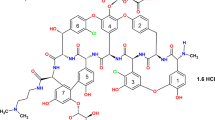Abstract
Purpose
The effect of monovalent (Na+ and K+) and divalent (Ca2+, Mg2+, and Zn2+) metal ions combined with citrate or acetate buffers (pH 4.5) on the stability of dalbavancin in aqueous solutions was investigated.
Method
RP-HPLC and HP-SEC were used to evaluate the stability of aqueous solutions of dalbavancin in different combinations of buffers and metal ions after four weeks of storage at 5°C and 55°C. A long-term study of formulations with divalent metal ions was conducted over six months at 5°C., 25°C and 40°C using RP-HPLC.
Results
All formulations in citrate buffered solutions precipitated. Dalbavancin solutions in 10 mM acetate buffer at 55°C were more stable in 10 mM CaCl2, 5 mM ZnCl2 and 10 mM MgCl2 than those containing 2 mM NaCl or 5 mM KCl, although the MgCl2 formulations precipitated slightly. No significant effect was observed for any of the divalent metal ions at 40°C for six months.
Conclusion
Dalbavancin’s stability in solution was improved by a combination of acetate and divalent metal ions at 55°C for four weeks. No effect was observed with acetate or metal ions alone, and no effect was observed after six months at 40°C suggesting that acetate and divalent metal ions together interact with dalbavancin via a thermally activated step to inhibit hydrolysis of the drug.






Similar content being viewed by others
Data Availability
Hikma Pharmaceuticals will not share the data beyond what is presented in the paper.
References
Editorial: Antimicrobial resistance: time to repurpose the Global Fund. Lancet (London, England). 2022;399(10322):335.
Durante ME. Parsimonious use of antibiotics in COVID- 19: A missed opportunity. Clin Infect Immun. 2021;6:29–30.
Basak S, Singh P, Rajurkar M. Multidrug resistant and extensively drug resistant bacteria: a study. J Pathog. 2016;2016:4065603. https://doi.org/10.1155/2016/4065603.
Giurazza R, Mazza, MC, Andini R, Sansone P, Pace MC, Durante-Mangoni, E. Emerging treatment options for multi-drug-resistant bacterial infections. Life 2021;11:519.
Leuthner KD, Buechler KA, Kogan D, Saguros A, Lee HS. Clinical efficacy of dalbavancin for the treatment of acute bacterial skin and skin structure infections (ABSSSI). Ther Clin Risk Manag. 2016;12:931.
Blaskovich MAT, et al. Developments in glycopeptide antibiotics. ACS Infect Dis. 2018;4.5:715–735.
Loll PJ, Derhovanessian A, Shapovalov MV, Kaplan J, Yang L, Axelsen PH. Vancomycin forms ligand-mediated supramolecular complexes. J Mol Biol. 2009;385(1):200–11.
Mackay JP, Gerhard U, Beauregard DA, Westwell MS, Searle MS, Williams DH. Glycopeptide antibiotic activity and the possible role of dimerization: a model for biological signaling. J Am Chem Soc. 1994;116:4581–90.
Cheng M, Ziora ZM, Hansford KA, Blaskovich MA, Butler MS, Cooper MA. Anti-cooperative ligand binding and dimerisation in the glycopeptide antibiotic dalbavancin. Org Biomol Chem. 2014;12(16):2568–75.
Scheinfeld N. Dalbavancin: a review for dermatologists. Dermatol Online J. 2006;12(4):6. https://escholarship.org/uc/item/0wn7d4q9
Package Inserts, DALVANCE, dalbavancin injection, powder, lyophilized for solution, Durata Therapeutics Inc., 2014. https://www.accessdata.fda.gov/drugsatfda_docs/label/2018/021883s007lbl.pdf. Accessed 13 Oct 2022.
Hoffmann M, Jin Y, Pöhlmann S. Dalbavancin: novel candidate for COVID-19 treatment. Cell Res. 2021;31(3):243–4.
Dalbavancin Compositions for treatment of bacterial infections, Stogniew et al., US Patent-2012, US 8143212 B2.
Manning MC, Chou DK, Murphy BM, Payne RW, Katayama DS. Stability of protein pharmaceuticals: an update. Pharm Res. 2010;27(4):544–575.
Avanti C, Amorij J-P, Setyaningsih D, Hawe A, Jiskoot W, Visser J, Kedrov A, Driessen AJM, Hinrichs WLJ, Frijlink HW. A new strategy to stabilize oxytocin in aqueous solutions: I. The effects of divalent metal ions and citrate buffer. AAPS J. 2011;13(2):284–290.
Jakaria SM, Budil DE, Murtagh J. Glycopeptide antibiotic drug stability in aqueous solution. AAPS Open. 2022;8(1):20.
Grimm W. Extension of the international conference on harmonization tripartite guideline for stability testing of new drug substances and products to countries of climatic zones III and IV. Drug Dev. Ind. Pharm. 1998;24:313–25.
International Conference on Harmonisation; Stability Data Package for Registration Applications in Climatic Zones III and IV; Stability Testing of New Drug Substances and Products; availability. Notice, Fed. Regist. 2003;68:65717–8.
Jakaria SM, Budil DE, Murtagh J. Strategies to stabilize dalbavancin in aqueous solutions; Section 3: the effects of 2 Hydroxypropyl-β-Cyclodextrin and phosphate buffer with and without divalent metal ions. Pharm Res. 2023. https://doi.org/10.1007/s11095-023-03525-w.
Veltri KT, Mason C. Medication-induced hypokalemia. Pharm Ther. 2015;40(3):185.
Nigudkar SS, Demchenko AV. Stereo controlled 1, 2-cis glycosylation as the driving force of progress in synthetic carbohydrate chemistry. Chem Sci. 2015;6(5):2687–704.
Wang W, Martin-Moe S, Pan C, Musza L, Wang YJ. Stabilization of a polypeptide in non-aqueous solvents. Int J Pharm. 2008;351(1–2):1–7.
Ananthanarayanan VS, Belciug M‐P, Zhorov BS. Interaction of oxytocin with Ca2+: II. Proton magnetic resonance and molecular modeling studies of conformations of the hormone and its Ca2+ complex. Pept Sci. 1996;40(5):445–464.
Liu D, Seuthe AB, Ehrler OT, Zhang X, Wyttenbach T, Hsu JF, Bowers MT. Oxytocin-receptor binding: why divalent metals are essential. J Am Chem Soc. 2005;127(7):2024–5.
Inactive Ingredients for FDA Approved Drug Products. https://www.accessdata.fda.gov/scripts/cder/iig/index.cfm. Accessed 18 July 2023.
Acknowledgements
This research work was supported by Hikma Pharmaceuticals.
Author information
Authors and Affiliations
Contributions
The authors confirm contribution to the paper as follows;
Research work was conducted in the lab, and the manuscript was prepared by Sardar M. Jakaria. David E. Budil and James Murtagh critically reviewed and revised the draft for intellectual content. All authors reviewed, edited, and approved the final version of the manuscript.
Corresponding author
Ethics declarations
Conflict of Interest
The authors state no conflict of interest in preparation of this manuscript.
Additional information
Publisher's Note
Springer Nature remains neutral with regard to jurisdictional claims in published maps and institutional affiliations.
Rights and permissions
Springer Nature or its licensor (e.g. a society or other partner) holds exclusive rights to this article under a publishing agreement with the author(s) or other rightsholder(s); author self-archiving of the accepted manuscript version of this article is solely governed by the terms of such publishing agreement and applicable law.
About this article
Cite this article
Jakaria, S.M., Budil, D.E. & Murtagh, J. Strategies to Stabilize Dalbavancin in Aqueous Solutions; Section-1: the Effects of Metal Ions and Buffers. Pharm Res 40, 2469–2478 (2023). https://doi.org/10.1007/s11095-023-03588-9
Received:
Accepted:
Published:
Issue Date:
DOI: https://doi.org/10.1007/s11095-023-03588-9




